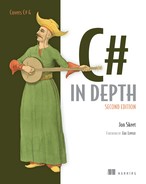Part 1. Preparing for the Journey
Every reader will come to this book with a different set of expectations and a different level of experience. Are you an expert looking to fill some holes, however small, in your present knowledge? Perhaps you consider yourself an average developer, with a bit of experience in using generics and lambda expressions, but a desire to know how they work better. Maybe you’re reasonably confident with C# 2 and 3 but have no C# 4 experience.
As an author, I can’t make every reader the same—and I wouldn’t want to even if I could. But I hope that all readers have two things in common: the desire for a deeper relationship with C# as a language, and at least a basic knowledge of C# 1. If you can bring those elements to the party, I’ll provide the rest.
The potentially huge range of skill levels is the main reason why this part of the book exists. You may already know what to expect from later versions of C#—or it could all be brand new to you. You could have a rock-solid understanding of C# 1, or you might be rusty on some of the details—some of which will become increasingly important as you learn C# 2, 3, and 4. By the end of part 1, I won’t have leveled the playing field entirely, but you should be able to approach the rest of the book with confidence and an idea of what’s coming later.
For the first two chapters, we’ll be looking both forward and back. One of the key themes of the book is evolution. Before introducing any feature into the language, the C# design team carefully considers that feature in the context of what’s already present and the general aims of the future. This brings a feeling of consistency to the language even in the midst of change. To understand how and why the language is evolving, we need to see where we’ve come from and where we’re going.
Chapter 1 presents a bird’s-eye view of the rest of the book, taking a brief look at some of the biggest features of C# 2, 3, and 4. I’ll show a progression of code from C# 1 onward, applying new features one by one until the code is almost unrecognizable from its humble beginnings. We’ll also look at some of the terminology I’ll be using in the rest of the book, as well as the format for the sample code.
Chapter 2 is heavily focused on C# 1. If you’re an expert in C# 1, you can skip this chapter, but it does tackle some of the areas of C# 1 that tend to be misunderstood. Rather than try to explain the whole of the language, the chapter concentrates on features that are fundamental to the later versions of C#. From this solid base, we can move on and look at C# 2 in part 2 of the book.
